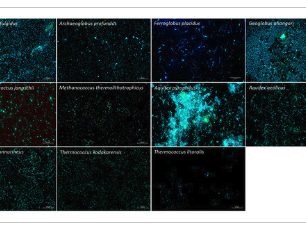Rabja Maria Popall, Alenica Heussner, Sven Kerzenmacher, Pierre-Pol Liebgott, Guillaume Pillot
Microorganisms 10 (2022): 2249
doi: 10.3390/microorganisms10112249
Microbial electrosynthesis has recently emerged as a promising technology for the sustainable production of organic acids, bioplastics, or biofuels from electricity and CO2. However, the diversity of catalysts and metabolic pathways is limited to mainly mesophilic acetogens or methanogens. Here, eleven hyperthermophilic strains related to Archaeoglobales, Thermococcales, Aquificales, and methanogens were screened for microbial electrosynthesis. The strains were previously isolated from deep-sea hydrothermal vents, where a naturally occurring, spontaneous electrical current can serve as a source of energy for microbial metabolism. After 6 days of incubation in an electrochemical system, all strains showed current consumption, biofilm formation, and small organic molecule production relative to the control. Six selected strains were then incubated over a longer period of time. In the course of one month, a variety of metabolic intermediates of biotechnological relevance such as succinic acid and glycerol accumulated. The production rates and the promotion of specific metabolic pathways seemed to be influenced by the experimental conditions, such as the concentration of CO2 in the gas phase and electron acceptor limitation. Further work is necessary to clearly identify these effects to potentially be able to tune the microbial electrosynthesis of compounds of interest.
© 2022, Creative Commons Attribution 4.0 International

